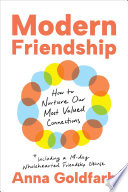

In the book, the author explores how friendship has transformed with the advent of technology. Traditional friendships relied heavily on face-to-face interactions, but now, social media platforms and instant messaging have created new forms of connection. The author discusses how these digital tools can both enhance and complicate friendships, allowing for instant communication but also leading to misunderstandings. The concept of 'friendship fatigue' is introduced, where individuals feel overwhelmed by the sheer number of connections they maintain online. The idea emphasizes the need to curate our friendships intentionally, focusing on quality over quantity.
Continue readingThe book delves into the significance of vulnerability in building strong friendships. The author argues that true connections are forged when individuals allow themselves to be seen, warts and all. By sharing our fears, insecurities, and struggles, we invite others to do the same, creating a safe space for open dialogue. This chapter also highlights the role of empathy in friendships, suggesting that understanding and validating each other's experiences is crucial for deepening bonds. The author provides examples of how vulnerability can lead to more meaningful conversations and a greater sense of belonging.
Continue readingFriendships often change as we move through different life stages, whether it's transitioning from college to the workforce or becoming a parent. The author addresses the challenges of maintaining friendships during these transitions, emphasizing the need for adaptability. This section includes practical advice on how to nurture friendships despite busy schedules and evolving priorities. The author encourages readers to be proactive in reaching out and making time for friends, even when life gets hectic. The importance of understanding that friendships may ebb and flow, yet still hold value, is a key takeaway.
Continue readingThis idea explores the dual-edged sword of technology in friendships. On one hand, technology allows us to stay connected with friends across distances, share experiences instantly, and maintain relationships that might otherwise fade. On the other hand, it can create superficial connections and lead to feelings of isolation. The author discusses how to leverage technology wisely, suggesting that we use it to enhance, rather than replace, face-to-face interactions. This chapter also addresses the phenomenon of 'social media envy' and how it can impact our self-esteem and friendships.
Continue readingSetting healthy boundaries is essential for maintaining balanced friendships. The author outlines the importance of recognizing personal limits and communicating them effectively. This chapter discusses various types of boundaries—emotional, physical, and time-related—and how they contribute to mutual respect in friendships. The author provides examples of situations where boundaries may be tested and offers strategies for navigating these challenges. The idea emphasizes that boundaries are not about pushing friends away but rather about fostering healthier, more sustainable relationships.
Continue readingWorkplace friendships can significantly impact job satisfaction and overall well-being. The author discusses the benefits of cultivating friendships at work, such as increased collaboration and support. However, the chapter also addresses the complexities that arise when personal and professional boundaries blur. The author offers advice on how to navigate these relationships, including maintaining professionalism while also being open and friendly. The importance of creating an inclusive work environment that encourages camaraderie is highlighted as a key factor in fostering strong workplace friendships.
Continue readingIn the concluding section, the author speculates on the future of friendships in an increasingly digital world. The discussion includes trends such as virtual reality social experiences and the potential for AI companions. The author encourages readers to remain optimistic about the future of friendships, emphasizing that while technology will continue to evolve, the fundamental human need for connection will persist. This chapter serves as a call to action for readers to actively shape their friendships in the face of changing societal norms and technological advancements.
Continue reading